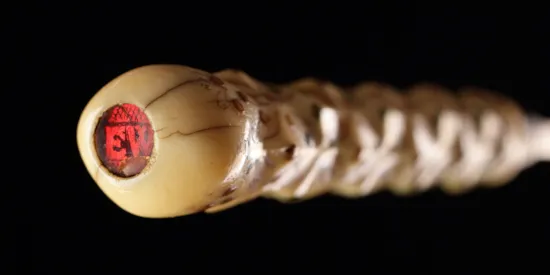Rare English Knife the Ivory Handle Carved with Lozenges Containing Green and Red Amber Insets
A Rare English Knife the Ivory Handle Carved with Lozenges Containing Green and Red Amber Insets
The tip inset with a red amber medallion engraved with the initials ‘EW’ the iron near-parallel blade with a cutlers mark
Circa 1620
Size: 20cm long - 8 ins long
The tip inset with a red amber medallion engraved with the initials ‘EW’ the iron near-parallel blade with a cutlers mark
Circa 1620
Size: 20cm long - 8 ins long
The handles of eating knives became much more elegant and decorative in the 17th century and changes to the shape of the blade occurred when eating habits dictated it was no longer necessary to spike food with a knife, so the blade became shorter with the sharp point removed.
As dining ceremony and cuisine changed so did the nature, provision and use of cutlery whether it was for the display of largesse and power, the cementing of political or business affinities or the enjoyment of the company and conversation of friends. During the 16th century cutlery was used at table for serving food rather than for eating it. However, during the next century this began to be superseded once the use of forks became the fashion.
As dining ceremony and cuisine changed so did the nature, provision and use of cutlery whether it was for the display of largesse and power, the cementing of political or business affinities or the enjoyment of the company and conversation of friends. During the 16th century cutlery was used at table for serving food rather than for eating it. However, during the next century this began to be superseded once the use of forks became the fashion.
Rare English Knife the Ivory Handle Carved with Lozenges Containing Green and Red Amber Insets

SOLD








YOU MAY ALSO LIKE

